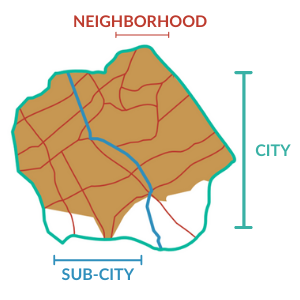Drivers of Health in Cities
SALURBAL analyzes urban data to reveal how cities impact health outcomes, health inequities, and environmental sustainability.

Learn more about SALURBAL’s data in the data brief “Data in the SALURBAL Project”:
Data in the SALURBAL Project (English PDF)
Los Datos del Proyecto SALURBAL (PDF en Español)
Os Dados do Project SALURBAL (Portuges PDF)
CITY, DISTRICT, AND NEIGHBORHOOD LINKS

SALURBAL's data is "linked" to the specific city and sub-city unit it's from. In some cases, the data is even linked to a specific neighborhood.
These linkages allow researchers to reveal differences within cities.
RESEARCH
The SALURBAL team is using this data to describe aspects of Latin American cities and their populations, and analyze how city environments and policies impact health and the environment:
DESCRIBE
- Patterns and levels of mortality, causes of death, and health outcomes.
- Patterns and levels of risk factors and heath behaviors.
- Urban built and social environments
ANALYZE
- Possible impact of urban environments (social and built) on health outcomes.
- Possible impact of urban environments on health equity
- Possible impact of urban policies and urban environments on environmental outcomes and sustainability.
COLLABORATION AND PARTNERSHIPS
SALURBAL’s data and research efforts are supported and implemented by the entire SALURBAL team.
Many agencies across the region contributed to the project through the generation, processing, and facilitation of access to data, or assisting with other aspects of the SALURBAL project that enables research.
SALURBAL’s DATA AND RESEARCH PROCESS
